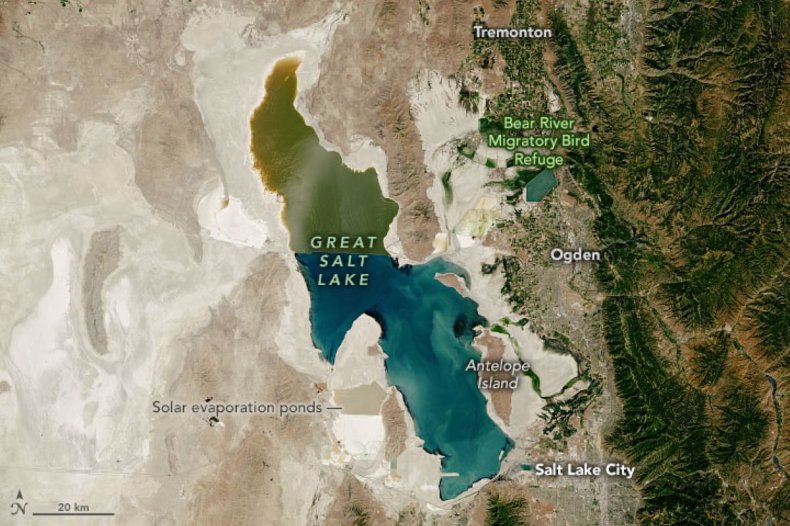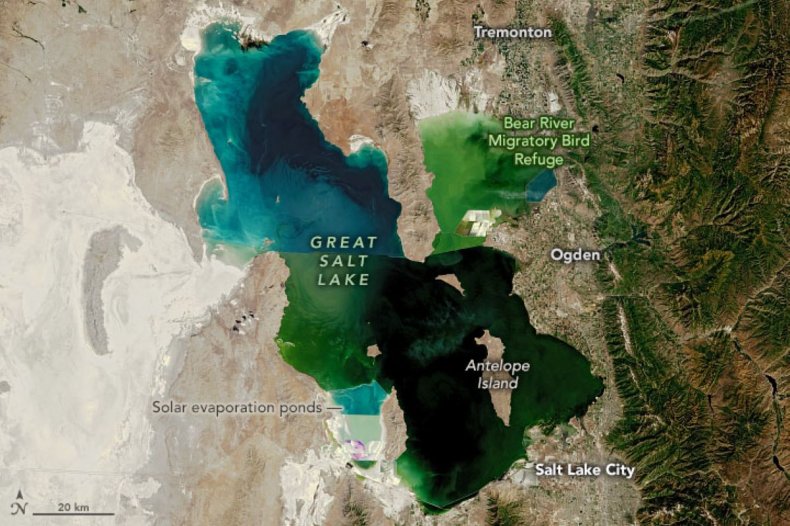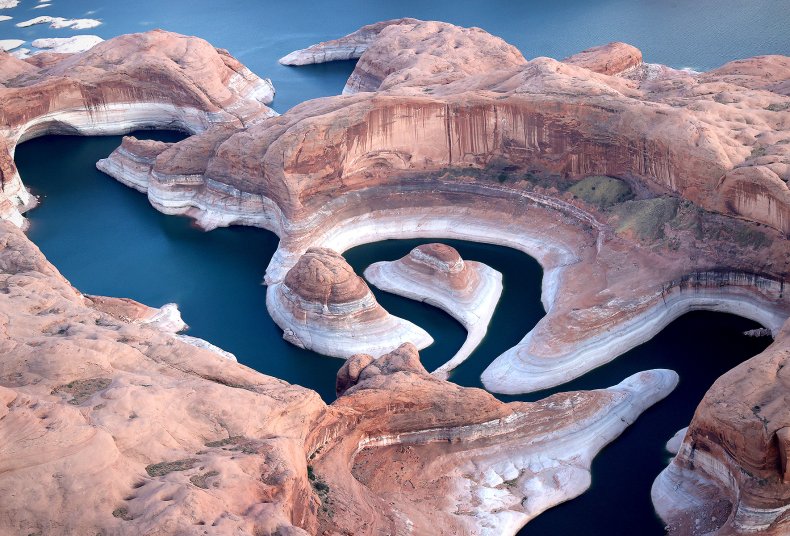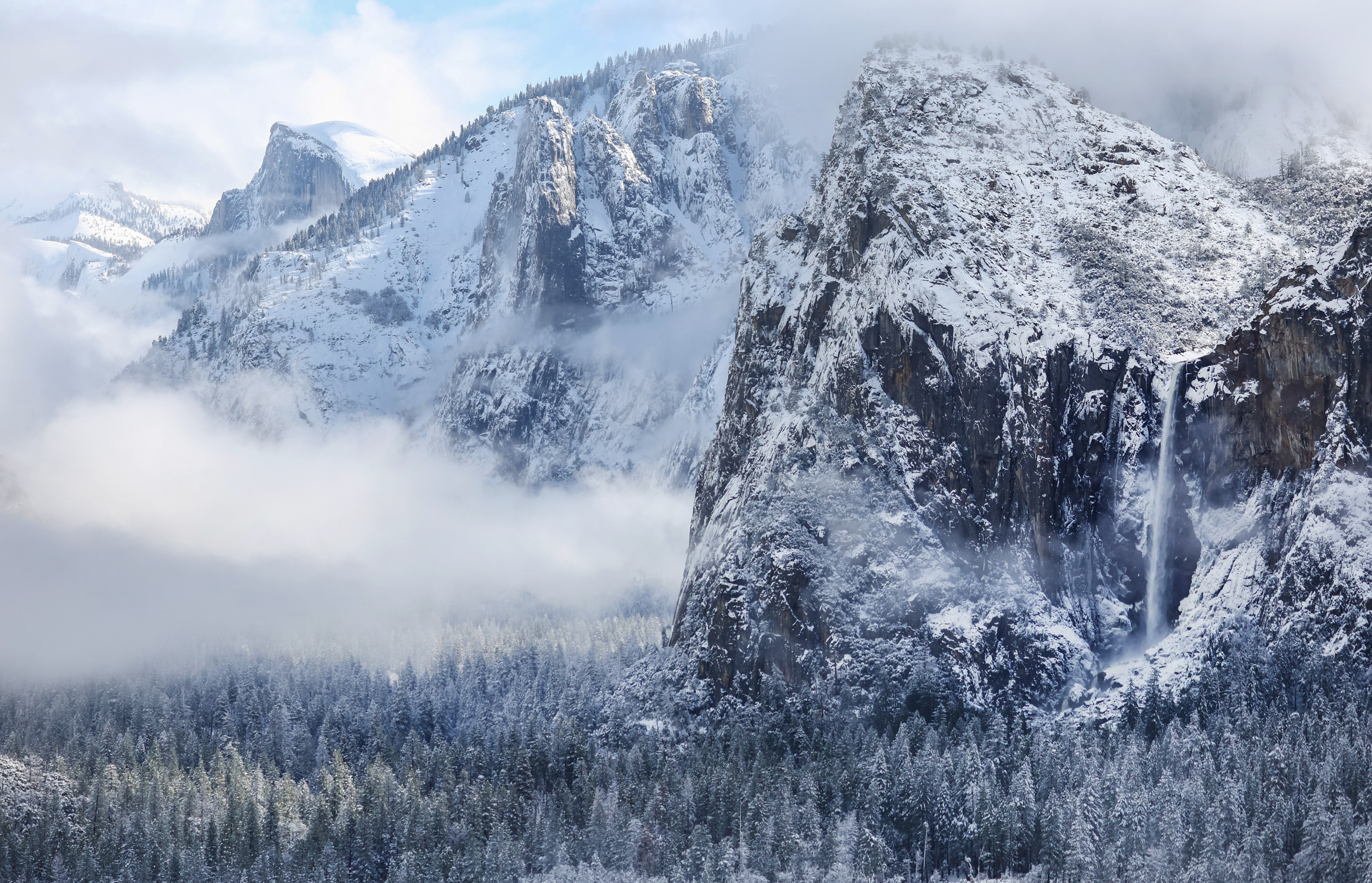The U.S. Lakes That Could Disappear
- Some of the U.S'. most famous lakes could disappear as climate change worsens.
- The Great Salt Lake in Utah could disappear in 10 years if nothing is done, an expert told Newsweek.
- Lake Mead could reach "dead pool" in just a few years, which would plunge the Southwest into a severe water crisis.
- Lake Powell hit its lowest levels ever this year.
As the climate crisis continues, some of the U.S' most famous lakes are in trouble. Some could even be gone in a decade's time.
Climate change is causing extremely long periods of drought, particularly in the western U.S—a region that has suffered extreme drought for over two decades. Rising water temperatures caused by climate change are enhancing evaporation, which in turn dries out the soil.
That means that with drought comes severe water shortages. Not only do warmer periods cause water to evaporate, but water sources are used much faster than they can replenish themselves.
Experts are already urging officials to implement measures to conserve water, but the future looks bleak if nothing is done.
Some lakes are in real danger of drying up completely if the situation worsens. Experts spoke to Newsweek about the lakes in the most peril.
The Great Salt Lake
Utah's Great Salt Lake— the largest saltwater lake in the Western Hemisphere—has reached historic lows in recent months. The lake has now lost 73 percent of its water.
Ben Abbott, plant and wildlife sciences professor at Brigham Young University in Utah, told Newsweek that it could be gone within just ten years.
"Irrigated agriculture has diverted too much of the river flow that Great Salt Lake depends on. If we don't increase the amount of water getting to the lake, it could be gone within a decade," Abbott said. "Even those who live far from Utah will be affected if we lose the lake. Industry and agriculture across the country and beyond depend on magnesium and fertilizer from Great Salt Lake, and it is the most important inland wetland in the western US."
The lake reached its lowest level in recorded history in November 2022, at 4,188.2 feet, 17 feet below the level it should be.
Abbott, along with two dozen other scientists and experts, contributed to a report released in January that outlined the dire consequences if emergency measures were not taken to save the lake immediately.



The study reported that a decline in the lake's water levels has been accelerating since 2020, "with an average deficit of 1.2 million acre-feet per year."
The scientists predicted an ever more dire outcome: that if the loss at this rate continues, the Great Salt Lake is on track to disappear in the next five years.
"The Great Salt Lake is primarily in trouble due to excessive human water use (and only secondarily in trouble due to the megadrought, caused by climate change)," Libby Blanchard, a postdoctoral research associate at the University of Utah and expert in energy, climate and environmental politics, told Newsweek. "Irrigation for agriculture is responsible for about 3/4 of the Great Salt Lake's total consumptive water use, for alfalfa and other crops."
The Great Salt Lake does not just provide water to farming, and other methods of human consumption, but is integral to the local climate and surrounding ecosystems.
"Great Salt Lake supports 80% of the wetlands in Utah and is the country's only source of magnesium," Abbott said.
"It also provides almost half of the world's brine shrimp supply, which is essential for aquaculture. About half of the farm-raised shrimp globally depends on Great Salt Lake for its brine shrimp. The lake also protects air quality in the western US. When these lakes dry up, their lakebed sediment can become sources of toxic dust that cause disease and premature death. The dust can also be deposited on snowpack, where it pollutes water supplies and causes early melt."
So what would happen if it dried up?
Blanchard said that if the problem is not tackled, it could go the same way as Owens Lake in Owens Valley, to the east of Sierra Nevada, California—which dried up in 1926 when its water was diverted to Los Angeles.
"The drying up of Owens Lake in California caused the worst dust pollution in the US. More than $2.5 billion has since been spent to reduce dust emissions from Owens Lake," Blanchard said.
"However, the Great Salt Lake is much bigger, and right next to a large metropolitan area. The human health implications of ever lower water levels could include poisonous dust storms from hazardous heavy metals and carcinogens in the lake bed sweeping through the area. The ecological implications could include an ecosystem collapse of the lake, which is a key ecosystem for 10 million migratory birds. Further, there are huge potential economic losses."
Spring snowmelt—which accumulated from many winter and early storms in the Western U.S—has recently risen the water levels of the Great Salt Lake, which has brought a sigh of relief for many.
However, Blanchard said that it is worth noting that "while record snowpack has helped the lake, it doesn't change the long-term outlook."
"The benefits are clear for saving the Great Salt Lake. We should not underestimate the consequences of losing the lake," she said.
Lake Mead
Lake Mead, the largest man made reservoir in the U.S., lies on the border between Nevada and Arizona, and is formed by the Hoover Dam on the Colorado River.
It is a popular recreational spot, but is now most famous for its rapidly declining water levels. Being located in an area seeing severe drought and water shortages, Lake Mead's water—which provides for 25 million people—is being used too quickly, with no means to replenish itself.
In summer last year, the lake reached its lowest level yet recorded at around 1,040 feet. This was the lowest it had been since it was constructed in the 1930s. As of May 10, the lake's water levels stood at 1,051.07 feet. The slight rise was due to wet weather that descended on the U.S. throughout winter, but again, it provides only a short-term solution.
The reservoir is inching closer to "dead pool" level, around 895 feet, which would have dire consequences for the surrounding areas—it would plunge the Southwest into a major water crisis. And experts predict that this could happen in just a few years.
A forecast from the Bureau of Reclamation released on August 31, 2022, shows the two and five-year projections at the lake. In the worst-case-scenario, the water level could fall to just above 990 feet in July 2024.
Karyn Stockdale, National Audubon Society's senior director for western water, told Newsweek: "[Lake Mead] could be at dead pool within a couple of years. This is the point at which water cannot pass the dams designed to provide water for California, Arizona, Nevada, and northwest Mexico."
The water irrigated through Hoover Dam shaped life in the southwest as we know it. Las Vegas, for example, would lose 90 percent of its water supply if water runs out.
"Ultimately, the only way to save the Colorado River and other major waterways in the West is to use less water. This means prioritizing system stability over maximizing all water deliveries. Our current rules, policies, and funding are not currently sufficient to protect the West for the medium or long-term," Stockdale said.
"While we've had some successes in aggressively changing federal, state, and local laws and acquiring funding—for both saving water and augmenting it—we need to keep our foot on the gas. All of us need to have a seat at the table to protect the our future in the West—this includes Tribes, the environment, agriculture, cities, and lawmakers at the state and federal level."

Lake Powell
Lake Powell is another Colorado River reservoir that faces the very real threat of drying up in the near future.
Along with Lake Mead, Stockdale said that 40 million people are at risk.
"They rely on the Colorado River water supply and a substantial share of the U.S. agricultural economy, not to mention the hundreds of bird species and every other living thing that depends on the basin's rivers as habitat."
In February this year, Lake Powell's water levels reached a historic low of 3,521.77 feet. The water levels has since risen to 3,532.90 feet as of May 9, but this is still dangerously low.
If the lake's water levels keep dropping at the current rate, they could reach dead pool levels of 3,370 feet in just a few years.
While the Great Salt Lake, Lake Mead and Lake Powell are of the most concern as climate change worsens, there are many others in the U.S. that face a dire future if nothing is done.
"Sadly, all lakes and reservoirs in the West are in trouble due to the ongoing drought. Yes, we had an above average winter with lots of precipitation—and particularly in some areas like California and Utah which are now flooding—but we would need more than a decade of above average winters to feel confident in our water supply," Stockdale said.
"The trends of the last three decades tell us that climate change, increasing water diversions to provide for our needs, and drought are here to stay. While some individual lakes and reservoirs are currently at ideal levels, a hotter spring and summer will put enormous pressure on the entire water supply."
Do you have a tip on a science story that Newsweek should be covering? Do you have a question about the U.S. lakes? Let us know via science@newsweek.com.








